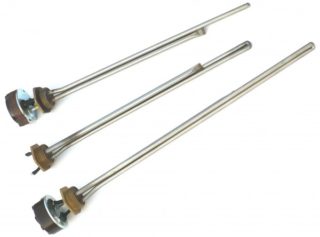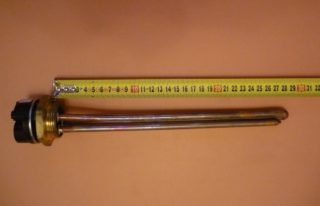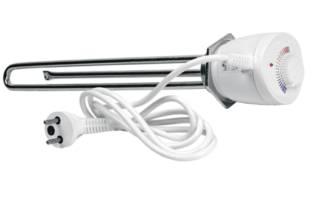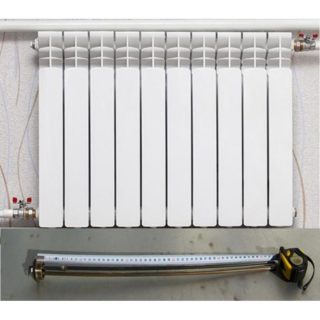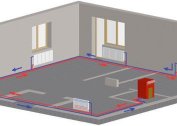Installing a heating element in the heating battery allows you to maintain optimal temperature conditions in any room. In stores you can see them in a large assortment, but before making a purchase, you must definitely make power calculations in order to purchase the most suitable option.
The device and principle of operation of heating elements
The heater in a cast-iron and aluminum battery has a rather primitive design. It is a cylinder made of metal, the inner cavity of which is equipped with a spiral made of durable copper / steel wire. Since the heater is equipped with a temperature controller, it is used to adjust the temperature regime of the carrier, and not just as a heating element.
The cylinder with a spiral is located in a sealed housing, which is equipped with a control sensor. Its main task is to prevent overheating of the device. Thanks to the galvanization process, additional reliability of the device is provided. Nickel plating and chromium plating increase the strength of the heating element, and also form an additional protective barrier.
Varieties of heating elements
TEN for a heating radiator can be made in several modifications. Each of them has individual technical characteristics and design features.
In terms of power, the heating elements for the heating battery vary between 0.3 - 6 kW.
According to the design of the housing, the heater for the battery can be with right and left threads. Such design solutions allow you to install them in batteries of various configurations.
The diameter of the heater in the heating radiator is divided into two varieties. Devices are designed for cast iron or aluminum radiators. In the first case, the diameter of the device is 1.25 inches, and in the second - only 1 inch.
Manufacturers can equip electrical appliances with additional functions:
- Turbo heating. This option allows you to force the increase in temperature in the room. It was possible to achieve this, since the built-in thermostat is able to modify the heating intensity. Such modifications are recommended to be installed in rooms with periodic attendance or outbuildings.
- Antifreeze. This option allows you to prevent possible freezing of heating appliances with the advent of cold weather. When the heater operates in this mode, the energy consumption is minimal.
When buying a heater, it is recommended that you familiarize yourself with the quality certificates of the goods, otherwise you can purchase a low-grade and fire-hazardous fake.
Advantages and disadvantages
An effective heating system can be created from a tubular thermostat, which can be used as additional or main heating.
Main advantages:
- Easy to install. Even an inexperienced person can cope with the task.
- Possibility of automatic control if the system is equipped with additional equipment.
- Reasonable cost of construction.
- Compared to oil coolers, the system is more reliable. The batteries are maintainable.
Of the shortcomings, it is worth highlighting impressive operating costs due to the high cost of electricity. You can reduce consumption, but for this you will have to additionally purchase an automated control system.
Selection options
When choosing an electrical appliance, the technical characteristics of radiators must be taken into account. The main criteria that affect the choice:
- Automatic control. Not all models are equipped with this option, but for convenience it is better to give preference to just such.
- Battery Type. In order for the thermostat to optimally suit the heating system, you need to study its technical passport.
- The length of the electric heating tube. The best option is 10 cm shorter than the battery length. Thanks to the correct selection, it is possible to uniformly warm up all sections.
Properly selected power is of great importance when choosing. Heaters can be installed up to 203 kilowatts.
For aluminum radiators
TENn for an aluminum radiator with a temperature regulator is no different from heating elements for cast-iron appliances. The differences are in the material of the stub and the shape of the outer part of the housing. The radiator has a plug with a diameter of 1 inch. The plug diameter of standard cast iron batteries is 1.25 inches.
When buying a heater, it is important to read the information on the packaging.
Power calculations
To select an electric heater of optimal power, you must first carry out the calculations.
- The power of an electrical appliance is determined by the amount of heat that will be required to heat the room. To heat 1 sq.m of a room, you need to spend 100 V. It is important to consider that the power and length of the heating elements must correspond to the needs of radiators.
- It will be necessary to calculate the volume of coolant in the structure. Even the most powerful heating elements will not be effective enough if the batteries do not have enough coolant (liquid). The volume of the cast-iron battery ranges from 0.6-1.5 liters, depending on the model, in aluminum radiators only 0.2 liters.
For about 1 kW of heater power, 15 liters of coolant is taken. Based on these data, the required number of sections and the power of the electric device are calculated.
Do-it-yourself rules for installing a heater in a battery
To install a heater in the battery does not need certain knowledge and skills. The main thing is to strictly follow the instructions and comply with safety requirements.
- Be sure to stop the water supply to the radiators and drain the residues from the system.
- Remove the bottom plug and install an electric heater in its place.
- After tightening the plug, the electronics are installed and water is again supplied to the system to check for leaks.
Safe Installation Rules:
- It is forbidden to use heating elements if the room is not equipped with an adequate ventilation system.
- There should not be any flammable objects near the device connected to electricity.
- Before proceeding with the design and installation of the heater, you need to make sure that the wiring can withstand the additional load.
- It is forbidden to dry shoes and clothes on radiators connected to the network.
Modern electric heating elements combine a large number of advantages, so that the demand for them is growing.
